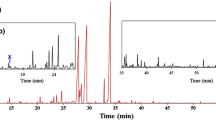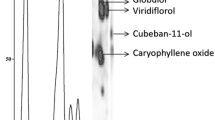Abstract
Multivariate curve resolutions (MCR) along with other chemometric techniques are proposed to improve the analysis of Iranian Elettaria cardamomum (E. cardamom) essential oil with gas chromatography-mass spectrometry (GC-MS). In addition, multivariate curve resolution-alternating least squares (MCR-ALS) is used to obtain pure elution and mass spectral profiles for the components present in each chromatographic segment as well as their relative concentrations. This strategy was also used to overcome the problems of baseline offset, asymmetric peaks, retention time shifts, and overlapped and embedded peaks occurring during GC-MS analysis. The analysis of GC-MS data revealed that 42 components exist in the E. cardamom essential oil. However, with the help of MCR and different chemometric methods, this number was extended to 73 components. The most important components of the Iranian E. cardamom are α-terpineol acetate (11.78 %), linalool (10.15 %), nerolidol (8.82 %), α-pinene (8.11 %), geranyl acetate (3.47 %),1,8-cineole (4.25 %), and γ-terpinene (3.88 %).







Similar content being viewed by others
References
Cuesta Sánchez F, Toft J, Van den Bogaert B, Massart DL (1996) Orthogonal projection approach applied to peak purity assessment. Anal Chem 68:79–85
Gemperline P (2006) Practical guide to chemometrics. Taylor and Francis, New York
Gholivand MB, Abolghasemi M, Piryaei M, Maassoumic M, Papzan A (2013) Microwave distillation followed by headspace single drop microextraction coupled to gas chromatography-mass spectrometry (GC-MS) for fast analysis of volatile components of Echinophora platyloba. Food Chem 138:251–255
Gurudutt KN, Naik JP, Srinivas P (1996) Volatile constituents of large cardamom (Amomum subulatum Roxb.). Flavour Fragr J 11:7–9
Jalali-Heravi M, Parastara H, Sereshti H (2008) Development of a method for analysis of Iranian damask rose oil: combination of gas chromatography-mass spectrometry with chemometric techniques. Anal Chim Acta 623:11–21
Jalali-Heravi M, Moazeni RS, Sereshti H (2011) Analysis of Iranian rosemary essential oil: application of gas chromatography-mass spectrometry combined with chemometrics. J Chromatogr A 1218:2569–2576
Jamal A, Javed K, Aslam M, Jafri MA (2006) Gastroprotective effect of cardamom (Elettaria cardamomum) Maton fruits in rats. Ethnopharmacol 103:149–153
Kapoor LD (2000) Handbook of ayurvedic medicinal plants. CRC Press, Boca Raton
Keller HR, Massart D (1991) Peak purity control in liquid chromatography with photodiode-array detection by a fixed size moving window evolving factor analysis. Anal Chim Acta 246:379–390
Kvalheim OM, Liang YZ (1992) Heuristic evolving latent projections: resolving two-way multicomponent data. Anal Chem 64:936–946
Marongiu B, Piras A, Porcedda S (2004) Comparative analysis of the oil and supercritical CO2 extract of Elettaria cardamomum Maton. J Agric Food Chem 52:6278–6282
Masoum S, Ghasemi-Estarki H, Seifi H, Ebrahimabadi E, Parastar H (2013) Analysis of the volatile chemical constituents in Mindium laevigatum by gas chromatography-mass spectrometry and correlative chemometric resolution methods. Microchem J 106:276–281
Naik JP, Rao JM, Kumar TM, Sampathu SR (2004) Chemical composition of the volatile oil from the pericarp (husk) of large cardamom (Amomum subulatum Roxb.). Flavour Fragr J 19:441–444
Prasath D, Venugopal MN, Senthilkumar R, Leela NK (2009) Hybrid performance for yield and yield components in cardamom. Euphytica 168:49–60
Ravindran MK (2002) Cardamom: the genus Elettaria. Taylor and Francis, New York, NY
Sereshti H, Rohanifar A, Bakhtiari S, Samadi S (2012) Bifunctional ultrasound assisted extraction and determination of Elettaria cardamomum Maton essential oil. J Chromatogr A 1238:46–53
Shen H, Stordrange L, Manne R, Kvalheim OM, Liang Y (2000) The morphological score and its application to chemical rank determination. Chemom Intell Lab Syst 51:37–47
Singh G, Kiran S, Marimuthu P, Isidorov V, Vinogorova V (2008) Antioxidant and antimicrobial activities of essential oil and various oleoresins of Elettaria cardamomum. J Sci Food Agric 88:280–289
Thomas E, Kizhakkayil J, Zachariah TJ, Syamkumar S, Sasikumar B (2006) Comparative quality characterization and molecular profiling of Indian, Sri Lankan and Guatemalan cardamoms. J Food Agric Environ 4:129–133
Valtiner SM, Bonn GK, Huck CW (2008) Characterisation of different types of hay by solid-phase micro-extraction–gas chromatography mass spectrometry and multivariate data analysis. Phytochem Anal 19:359–367
Windig W, Stephenson D (1992) Self-modeling mixture analysis of second-derivative near infrared spectral data using the SIMPLISMA approach. Anal Chem 64:2735–2742
Zheng W, Wang S (2001) Antioxidant activity and phenolic composition in selected herbs. J Agric Food Chem 49:5165–5170
Compliance with Ethics Requirements
This article does not contain any studies with human or animal subjects.
Conflict of Interest
Mohammad Asadollahi-Baboli declares that he has no conflict of interest. Ahmad Mani-Varnosfaderani declares that he has no conflict of interest.
Author information
Authors and Affiliations
Corresponding author
Rights and permissions
About this article
Cite this article
Asadollahi-Baboli, M., Mani-Varnosfaderani, A. Chemometrics-Assisted GC-MS Analysis of Volatile and Semi-Volatile Constituents of Elettaria cardamomum . Food Anal. Methods 7, 1745–1754 (2014). https://doi.org/10.1007/s12161-014-9815-9
Received:
Accepted:
Published:
Issue Date:
DOI: https://doi.org/10.1007/s12161-014-9815-9




